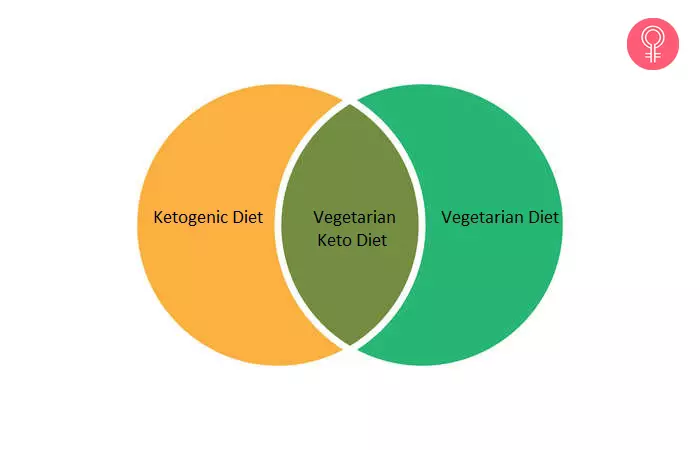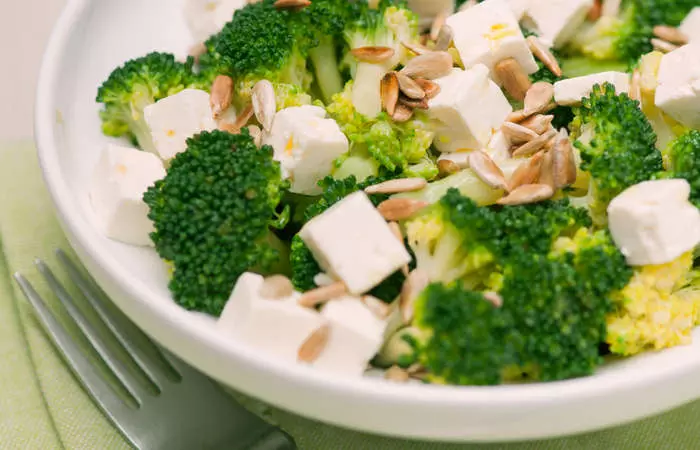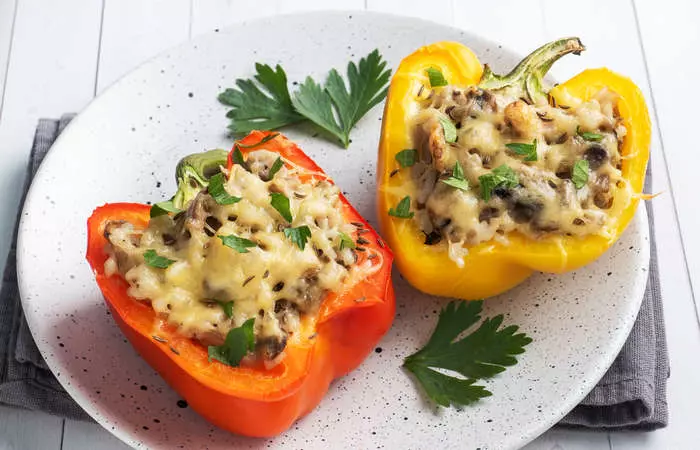What Is A Vegetarian Keto Diet All About?
A vegetarian keto diet is a modified ketogenic diet without meat and eggs. This diet requires you to consume approximately 55%-60% fat, 30%-35% protein, and 5%-10% carbohydrates (1). But all the foods you consume are mainly from plant sources (except dairy). This slight customization helps include vegetarians in the keto diet club and enjoy the health benefits of the keto diet – weight loss being one of the most popular ones. You can check this ketogenic calculator to find your nutrition needs to reach your health or weight loss goals. But how can eating so much fat help you lose weight? Find out in the next section.
How Does The Vegetarian Keto Diet Work?
When you are on a vegetarian keto diet, your body no longer uses sugar or carbs as the primary fuel source (1). It starts using ketones (hence the name) instead. When the carb supply is cut off, your body first switches to using the glycogen (a stored form of glucose), then lactic acid, glycerol, and protein. Finally, ketogenesis sets in. This process breaks down fat into ketone bodies (excellent energy sources that are an alternative to glucose). The liver continues to produce ketone bodies as long as the carb intake is near to none. This state is known as “nutritional ketosis.” Now that you know that this high-fat and low-carb diet actually works, here’s a sample menu plan. You can customize this menu according to your food habits. Apart from the foods mentioned in the sample diet chart, here’s a list of vegetarian keto-friendly foods you can add to your shopping bag. Scroll down.
Vegetarian Keto Diet Foods List
Non-Starchy Vegetables: Broccoli, cauliflower, zucchini, spinach, arugula, asparagus, bell pepper, and kale. Fats: Olive oil, avocado oil, MCT oil, coconut oil, peanuts, peanut butter, almonds, almond butter, pistachios, pecans, hazelnuts, macadamia, walnut, cashews, Brazil nuts, coconut, chia seeds, flax seeds, butter, ghee, and cheese. Proteins: Tofu, cottage cheese, mushrooms, eggs (if you eat eggs), lentils and beans in moderate amounts, and keto-friendly vegetarian protein powders (pea, whey, soy, and hemp proteins).
These are the main food groups you should include in your diet. But humans are all about their habits. So, for beginners, here’s a gentle reminder of the high-carb foods to avoid when switching to keto. Scroll down.
High-Carb Foods To Avoid
Take these off your shopping list for as long as you are going to be on a vegetarian keto diet: Potato, beetroot, yam, corn, sweet potato, cassava, rice, brown rice, quinoa, buckwheat, cereal, legumes, beans, white and wheat breads, pasta, couscous, wheat and refined flours, mango, banana, apples, orange, pineapple, watermelon, grapes, grapefruit, plum, pear, pretzels, bagels, doughnuts, all packaged foods, bottled sauces, candies, cookies, cakes, soda, and soft drinks. Your vegetarian keto grocery list is ready. The next step is to start being on this diet. Learn how to get started in the next section.
How To Start A Vegetarian Keto Diet?
The first step is always the hardest. But not anymore. Here’s a complete plan to prep and help you start the vegetarian keto diet ASAP:
First, talk to a licensed nutritionist/dietitian to know if going on a keto diet will benefit you. Your dietitian will analyze your food habits, lifestyle, medical history, and current medications before giving you the go ahead. Buy the foods you need and like to sustain the keto diet. Search for places that serve keto-friendly foods in case you decide to eat out or order in. Talk to your friend who is on the keto diet wagon for tips on foods and recipes. Follow vegetarian keto blogs and vlogs. Join a vegetarian keto diet group to stay motivated. Donate all high-carb foods to a shelter. Out of sight, out of mind! Avoid going to the processed food aisle in the supermarket. Start any day but start with a good dose of bulletproof coffee (tastes great!) to get your vegetarian keto journey going every single day.
With these starter points in mind, let’s now delve deep into the health benefits of the vegetarian keto diet.
Research-Based Health Benefits Of Vegetarian Keto Diet
It can help reduce weight (1). It may prevent diabetes and can be used as a diabetes diet (2). It reduces the risk of cardiovascular diseases (1). It has shown promising results in treating epilepsy, ALS, and dementia (1). It may reduce the progression of some types of cancer (3). It reduces the risk of respiratory diseases (3). It may help reverse retinopathy (loss of vision) and kidney disease (4). It reduces recovery time and enhances a sense of well-being in athletes (5). It helps regulate blood pressure(1). It may help reduce acne (3).
Aishwarya Anand, a blogger, shared her experience with a vegetarian keto diet. She wrote about her progress after following the diet religiously for a month. She mentioned, “Although the first couple of days were hard, at the end of it I felt fresher and more energized. There was a visible glow on my face and I was more motivated to work (i).” Undoubtedly, the ketogenic diet is reputed to have many health benefits. Adding to it, the vegetarian keto diet discourages meat intake, which has its own advantages. But does excluding other vegetables, fruits, legumes and beans, and whole grains impact your overall health? Let’s find out what happens to your body when you exclude other foods for a long time. Scroll down.
The Not-So-Good Side Of A Vegetarian Keto Diet
Vegetarian keto diet may cause (1)
Keto flu. The symptoms are insomnia, nausea, headache, fatigue, vomiting, constipation, dizziness, and difficulty in exercise tolerance. However, this condition is usually short-lived (may last from 2 days to 2 weeks). Vitamin and mineral deficiencies (these can be avoided if the diet is well-designed)
Thankfully, you can reduce the risk of the disadvantages of the vegetarian keto diet. Here are some effective ways.
Ways To Prevent Nutritional Deficiency
The best ways to prevent nutritional deficiency is to:
Take vitamins and mineral supplements. Consume keto-friendly vegetarian protein drinks. Practice keto cycling. Follow a keto diet for a month or two and then take a break. Consume a high-protein diet (including legumes and beans) and healthy carbs like vegetables, fruits, and whole grains for 2-3 weeks.
With so much in your vegetarian keto diet knowledge bank, there’s one thing that can make sustaining keto quite tough. And that is knowing to cook vegetarian keto recipes. Here are three recipes that will get you started. Take a look.
3 Yummy Vegetarian Keto Recipes
1. Bulletproof Coffee
Ingredients
1 cup of brewed coffee 1-2 tablespoons of MCT oil (1 teaspoon for beginners) 1-2 tablespoons of unsalted butter or 1-2 teaspoons of ghee
How To Prepare
2. Broccoli Cottage Cheese Salad
Ingredients
½ cup of cubed cottage cheese ½ cup of broccoli florets 1-2 teaspoons of sunflower seeds or pepita 1 dollop of butter Salt and pepper to taste A dash of olive oil
How To Prepare
3. Cheesy Mushroom Stuffed Bell Pepper
Ingredients
½ cup of chopped button mushrooms 1 bell pepper, halved 1 to 2 tablespoons of grated cheese Salt and pepper to taste 1 tablespoon of butter Finely chopped parsley
How To Prepare Yummm! Aren’t they? That’s the best part about the vegetarian keto diet. You can eat delicious food and lose weight! But one question remains to be answered – can you be on this diet if you have any medical complications? Find that out below.
Should You Try The Vegetarian Keto Diet?
The vegetarian ketogenic diet is for those who want to get all the benefits of the original keto diet, including weight loss and preventing obesity-related diseases (1). But to be on it, you must consult your doctor or dietitian. Also, this diet depends on your food habits. Are you prepared to consume a high-fat, moderate-protein, low-carb diet for several months? Does it suit your lifestyle? If you cannot sustain this diet, you will not benefit from it. If your doctor approves your decision to start going on a keto diet and you have answered “yes” to most of the questions above, you are perfect to start the vegetarian keto diet. Can you have yogurt on keto? Yes. Plain yogurt is one of the dairy substitutes that can be consumed while on a ketogenic diet. Is almond milk keto-friendly? Yes. Due to its low carb content, unsweetened almond milk is a fantastic, keto-friendly choice.
Discover the intricacies of a vegan keto diet by watching the video below. Learn a few tried-and-tested nutritious recipes that can make a flavorful addition to your diet for a vegan keto lifestyle. (i) Vegetarian Keto Diet — A Myth or a Reality? https://medium.com/@aishu.anand07/vegetarian-keto-diet-a-myth-or-a-reality-13edf4ef72ad









